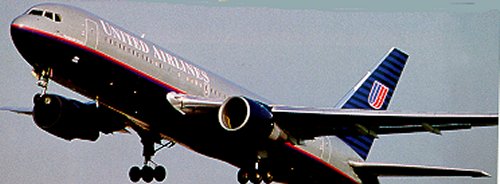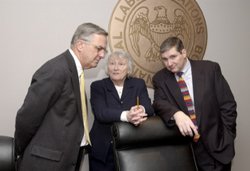 |
|
Indianapolis-based
aircraft technician John Cherny at a recent Indianapolis State
House rally with 3-year-old John Cherny Jr. and 6-year-old Kala
Hans.
|
 |
| Failure
to respond to IAM contract concerns cost former CEO James
Goodwin his job at UAL. |
Return to Contents Page
|

The two-year roller coaster ride for
45,000 IAM members at United Airlines took some sharp turns recently.
And the white-knuckle ride is not over yet.
Take a look at the obstacles UAL employee-owners and IAM negotiators
faced since talks began in 1999.
On May 24, 2000, six months into negotiations, United announced plans to
acquire US Airways for $11.6 billion. The prospect of protecting 60,000
IAM members under six contracts at two airlines quickly complicated
negotiations.
Then came the record- setting
contract for United’s pilots. Their August 2000
contract gave employees a glimpse of what UAL had to offer.
Contract votes at other airlines raised expectations of IAM members
whose pay was fixed at 1994 levels.
As employee relations soured, United made costly investments in aircraft
and Internet ventures. Managers sought court orders against increasingly
frustrated employees. A raider organization that exists only to
interfere with legitimate unions gave United the excuse to halt
negotiations until the government ruled their bid for an election was
unwarranted.
On March 7, 2001, the IAM advised the Justice Department that United
Airlines’ proposed merger with US Airways was a threat to employees,
passengers and shareholders alike. “Without written job security
language for members at both carriers, the deal was doomed,” said
Robert Roach, Jr., IAM General Vice President.
The United-US Airways merger died on July 27, 2001. By then, the
recession was in full swing. United felt it first. Way back in October
2000, UAL reported a quarterly loss of $64 million –– it’s first
loss since 1993.
UAL managers reacted by furloughing hundreds of employees, abandoning
line stations, shuttering dozens of ticket offices and closing overnight
maintenance facilities –– all prior to September 11.
An industry-wide bailout, massive layoffs, the Biz Jet check, a
poisonous letter, and Jim Goodwin’s resignation
followed like dominoes.
 |
The
PEB: Confounding expectations, the Bush-appointed board
recommended immediate raises for IAM members at UAL. From left,
board members David Twomey, Helen Witt, and Ira Jaffee |
On December 20, 2001,
a Presidential Emergency Board (PEB) was appointed to intervene
in the mechanics’ negotiations.
On January 20, the PEB rejected the carrier’s argument for a pay
freeze and recommended an immediate 37 percent wage hike for mechanic
and related members at United. “The board recognized the merits of our
case. Even so, we strongly opposed this third party intervention in our
negotiations,” said Scotty Ford, District 141-M president and lead
negotiator for the UAL mechanics group.
United accepted the PEB recommendations, making them their “last best
offer.” On February 12, 2002, District 141-M members voted to reject
that offer by a wide margin. With the 30-day
cooling off period deadline looming, the IAM called for non-stop
talks to hammer out a new agreement.
“The 30-day cooling off period is where difficult negotiations are
often resolved,” said GVP Roach. “But the members at United will
decide,” said GVP Roach. “That’s what we’ve been fighting for
all along. And that’s what we’ll continue to fight for.”
Update: The IAM and UAL came to a tentative
agreement on February 18, and the IAM agreed to extend the strike
deadline until March 7. Members vote on March 5 whether to ratify the
agreement.
Related link:
District 141M
|